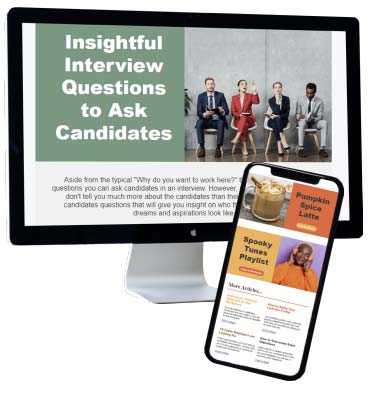Before You Go!
Sign up for our newsletter - which features professional templates, job market updates, articles, playlists, recipes, and more, sent directly to your inbox!



To put it simply, a cover letter is a short letter summarizing your qualifications for the job you are applying to. However, it’s not just a summary of your resume. Your cover letter is your chance to introduce yourself in a memorable and personal way. While your resume will go into detail about your specific qualifications, skills, and work history, your cover letter should introduce who you are, your work ethic, your personality, and what makes you the best choice for the position.
Thinking about what to include in your cover letter can seem like a daunting task. How do you simplify years of experience and skill-building to fit onto one sheet of paper? To make a cover letter the least of your worries on your next job application, we’ve put together this guide on how you can write an effective and unique cover letter.
Before we get into how you can write a cover letter, let’s start with what a cover letter is and why it is so important in the job application process. Many resources will tell you that a cover letter is just a summary of your resume, but this is a crude definition of what a cover letter actually is. A cover letter adds a personal touch to your job application and introduces not just what you’ve done, but who you are. While your cover letter should summarize SOME aspects of your resume, it should also complement it with new information the hiring manager might not have been able to get from your resume – such as why you are interested in that specific position.
Your cover letter is your first introduction to the hiring manager and first impressions are everything. You don’t want to leave the hiring manager with an unclear depiction of who you are or why you belong in that position. That’s why it is so important to have a cover letter that is memorable, unique, and will leave a strong impression of your personality and skills. All of this should align with the job you’re applying for, which is why you should write a new cover letter (or at least tweak it accordingly) for every job you apply for. Of course it’s faster to have a generic cover letter, but this defeats the purpose of a cover letter, which is to show a hiring manager how you fit perfectly for that specific position.
Every cover should be in the format of a professional letter with a header, greeting (or salutation), introduction, body, call to action, and valediction (or complimentary close). The header for your cover letter should have your Name and contact information (Including your: Phone Number, Address, and Email) in a format similar to your resume. Make sure to use a professional font in the Serif or Sans-Serif family such as Times New Roman or Calibri. The font you use should be the same for both your cover letter and resume, so adjust accordingly. Having a consistent format for your documents will make them feel more professional.

To start your position-specific cover letter, avoid using the obligatory “To Whom it May Concern,” which might cause you more harm than good. Instead, use a more specific greeting that is relevant to the position you’re applying for. Even if you did your research and found the name of the manager for the department you’re applying to, there’s no certainty that’s who will be reviewing your resume. Greetings such as “Sales Assistant Hiring Manager” or “Business Consultant Search Committee” would be the perfect way to address anyone involved in the hiring process for that specific role. Having a more specific greeting will instantly make your cover letter more personal and identifiable.
Following your greeting, the first sentence of your cover letter should be an attention grabbing, brief introduction to you. For example, “I’ve been giving my friends and family free style advice since I was 10, and recently decided it’s time to make a living out of this skill. That’s why I couldn’t believe it when I found a personal stylist position at J. Hilburn.” Including your personality in your introduction will make your cover letter stand out and help the hiring manager feel connected to you. Be sure to include the job you are applying for, since many companies will have combined resumes for several positions. Need some inspiration for your introduction? This article from the muse on how to start a cover letter has over 30 great examples you can draw inspiration from.
We’ve said it before but let’s reiterate this point: Your cover letter is NOT just a summary of your resume. Use your cover letter to expand or compliment your resume. For example, if you have two different roles listed on your resume at the same company (i.e. you were promoted) highlight how that happened. Use your cover letter to focus on your greatest career and life achievements.
When you’re writing your cover letter, you’re telling your story. Focus on specific examples or achievements throughout your career that highlight your personality and work style. The best way to decide which career stories to tell is to research more about the company. Learning about the company’s culture and goals will help you articulate how your own goals and personality align with the company’s.
Think about your cover letter as your “argument” and your resume as the data that backs it up. If your resume says you helped increase sales for your company by 200%, use your cover letter to show the hiring manager what that means you bring to the table. You can say something along the lines of, “At ____ I learned that connecting with your clients generates an important relationship that will keep them coming back to you.” This will show them that you have not just achieved results in the past, but that you have a deep understanding of how to do it again.
Once you’ve come up with the perfect introduction and expanded on your career achievements and skills, you’ll need to end your letter with a strong conclusion and a call to action. Give the hiring manager a reason to contact you (without crossing any boundaries). Remember to never assume anything. Saying “I’ll call to schedule an interview” can be seen as obtrusive and might ruin your chances of actually getting an interview. Use a call to action that is both polite and open-ended and suggests that you are excited to further discuss your qualifications. The following is a great example of a call to action that is both polite and confident without crossing a line: “I would appreciate the opportunity to meet with you in person to discuss my qualifications and answer any questions you may have. I look forward to hearing from you.”
After you’ve written your call to action, finish the letter with a professional valediction (or complimentary close). Your valediction should mirror the tone of your opening salutation. Saying “Thanks” might be a bit too informal for a cover letter, so make sure to choose a more appropriate close. The following are some professional valedictions that would be appropriate for a cover letter:
We’re all guilty of this. We finally finish writing out the perfect cover letter and get so excited, we send it without taking a second look! Suddenly, you’ve sent (to what could be your potential future employer) a letter riddled with typos and run-on sentences. Avoid the embarrassment and read through your cover letter once you have finished writing it. Spell-check has its limitations and won’t always be able to tell you when there is an issue with your writing, so make sure you do a thorough read through of your cover letter. After you’ve completed your proofread, have a friend or family member look at it for you too. Having a fresh pair of eyes can go a long way.
Once you have perfected your cover letter, make sure your resume is polished with these Resume Dos and Don’ts. Good luck on your job hunt!
